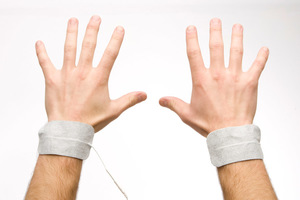TENS electrical stimulation will help with the circulation of blood, lymph and fluids
Understanding circulation
Blood
The blood circulation system is the prime method of getting needed oxygen and nutrients to the cells of the body. If blood flow in an area is poor then the cells will find it very difficult to get all of the energy and food nutrients they need to enable the body to operate in a healthy manner.
Poor circulation can be very unpleasant. If it isn't treated, it can lead to a lifetime of discomfort and even more serious problems.
If you believe you have poor circulation, get it checked by your medical practitioner.
Potential causes
Peripheral Artery Disease - (PAD) can lead to poor circulation in your legs. PAD is a circulatory condition that causes narrowing of the blood vessels and arteries.
Blood Clots - partially or entirely block the flow of blood. They can develop almost anywhere in your body, but a blood clot that develops in your arms or legs can lead to circulation problems.
Varicose Veins are enlarged veins caused by incompetent venous valves. The veins appear gnarled and engorged, and they are most often found on the back of the legs. The damaged veins cannot move blood as efficiently as other veins, so poor circulation may become a problem.
Diabetes - can cause problems in many different areas of your body. Poor circulation caused by diabetes can cause leg cramping, as well as pain and cramping in your calves, thighs, or buttocks. People with advanced diabetes may have a difficult time detecting the signs of poor circulation because diabetic neuropathy can cause reduced sensation in your extremities.
Raynaud’s Disease - presenting as cold hands and feet. This disease causes the small arteries in your hands and toes to narrow. Narrowed arteries are less capable of moving blood through your body.
Fluid
Water retention, also known as fluid retention refers to an excessive build up of fluid in the circulatory system, body tissues, or cavities in the body. Up to 70% of the human body consists of water and water exists both inside and outside our body's cells.
If circulation is compromised, fluid can remain in the tissues, causing swelling in various parts of the body, including the abdomen, ankles, legs and feet. (It is also called oedema).
Lymph
The lymphatic system is a network of vessels that carry a clear fluid called lymph. Fluid that is forced out of the bloodstream during normal circulation is filtered through lymph nodes to remove bacteria, abnormal cells and other matter.
Using TENS therapy for Circulation
As part of your management plan for diagnosed poor circulation, you may use electrical nerve stimulation and cell stimulation.
ActivBody is the TENS machine we suggest for circulation issues.
ActivBody electrotherapy can be used everyday - outside the clinic for an effortless, regular aid to better circulation. It is designed to be used on the move and suitable for use during long plane or car journeys.
How to use ActivBody for improved circulation
User Guide
Please read the User Guide that comes with your TENS machine.
Pad placements - Circulation
Lower body - Place the pads at the back or front of each ankle. The signal passes back and forth between the two pads. This means that the muscles and circulatory system of both legs are being stimulated.
Upper body - Place the pads on either wrist.
One limb only - Place one pad at the most affected joint and the second pad 15 to 20cm away.
These are examples only. Please phone us if you need further advice.
Mode, Intensity, Time and Repeat frequency - Circulation
Please click the image for more information.





